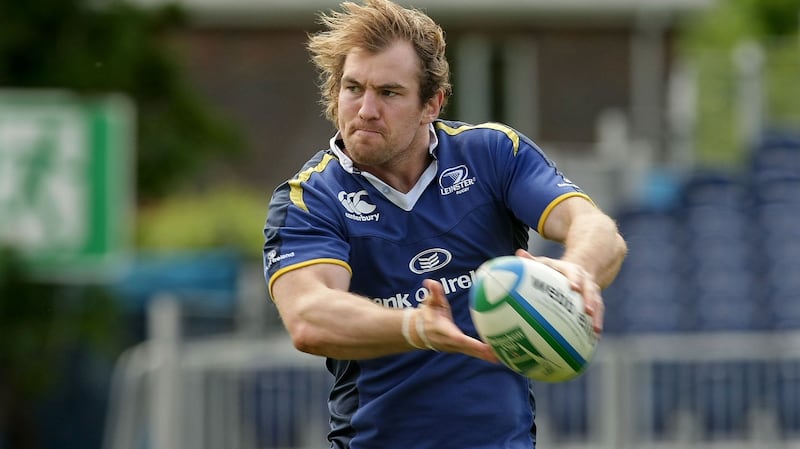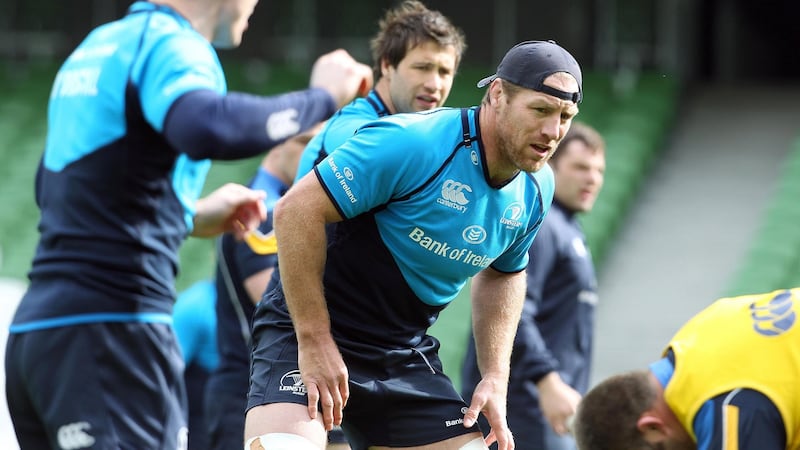I never really trained with Dan Leavy but I did spend a special season alongside Rocky Elsom. If there is a correlation between their methods, as Johnny Sexton joked on the pitch after Leavy dominated against Saracens, then everyone in Leinster will have adjusted by now.
There is always an exception that proves the rule.
If Leavy is that man at training, yet performing to a standard that would have him shortlisted for world player of the year (if the vote was in April), then people will understand. Maybe he is on to something; we train to be perfect in games. That’s the whole point.
Now, there are many ways of doing this. In Ireland, due to the Joe Schmidt effect, enormous emphasis and value has been placed on replicating match scenarios in Carton House.
CJ Stander spoke about entering “the dark places” they had already visited in training when the carry count ticked into double figures in Paris. There was a familiarity due to the intense nature of Schmidt sessions; the routine of error-free performance.
Unbelievable results have followed but training can never truly replicate a game. That’s why you always hear about the B team tearing the As apart. The B’s know the moves so they rarely defend like the actual opposition.
Training can also give a team a false sense of security.
The All Blacks have a clear advantage in that they are not overly structured. They rely on brilliant individuals reacting to what’s in front of them. So there is not much that can go wrong.
Rocky Elsom wasn’t a bad trainer. Having come straight from a season with the Wallabies, he knew how to mind himself in order to be explosive in games.
By 2009 I was all about ticking every single box at training. I regret this a little now but it was just how I evolved as a player. Circumstances played their part. I had to change perceptions by turning up on time and letting my hair return to its natural colour.
Monday to Friday, for me, was all about creating headspace similar to game day. This meant, sometimes, I went into the weekend mentally fatigued. You can’t live in the performance zone 24/7. Believe me I tried. It’s counterproductive.
Quick recycle
I was all about eradicating mistakes but that – I see now – was my mistake. Errors can make you a better player. Trying and failing brings you closer to completing an offload in contact or accurately throwing a long pass a fraction before the hit. This would have made me a superior second-five-eight but instead I worked tirelessly on taking contact on my terms and perfecting ball placement for a quick recycle. I became reliable, dependable and predictable.
What you do in the lead up to a match can dictate your mindset come kick-off
Geordie Murphy would try all sorts of tricks in training and, as a result, he trusted himself on the field so when a unique scenario presented itself he was rarely found wanting.
I removed risk, where possible, and with it went doubt about what I was going to do. Normally you earn the right to be spontaneous, I had to earn respect as a dependable player.
This was an achievement in itself.
What you do in the lead up to a match can dictate your mindset come kick-off. Early in my work with Enda McNulty we went through the pre-match routine, which had regressed back to schools days, when I played my best rugby. There was so much clutter, every minute was filled with something like cleaning boots, meal preparation, scheduled sleep. If one element fell out of sync, the very routine that was designed to get me ready for the match would be sabotaged. I would be so concerned about my “lucky” socks that I would drop the first ball.

We removed the debris one piece at a time to create a simple routine that could be easily amended when something went wrong.
By the 2013/14 season I’d become a more rounded centre, playing some of my most complete games for Ireland (certainly against the All Blacks in that agonising defeat) but the clock was ticking on my career.
Rocky didn't shirk the work, he was present and engaged, he just knew what was needed to perform every weekend. Nobody was complaining.
Imagine knowing back then what you know now?
Training does need to be regimental but I see a big flaw in the modern player. When the ingrained mechanics of getting ball to the wide channel isn’t available the majority of the time they hold on and go to ground (I was a primary example). The outlier – who isn’t overly process driven – will grubber into space or do whatever it takes. The risk increases but so does the reward.
Improvisation is a skill. I rarely improvised because I didn’t practice outside the parameters of our set plays, along with catch and pass drills. I forgot the extra value of what training could have been as I was so busy rehearsing for match scenarios we were certain would materialise.
Big leap
It’s a big leap to put Leavy in that category but if he’s anything like Rocky then he’s figured out the best way of getting himself mentally and physically primed for games.
What is clear is a player must be delivering at a Dan Leavy or Rocky Elsom level for people to accept a process that is at odds with accepted norms. But there is always an exception that proves the rule. Leinster have used 53 players this season so there has to be certain allowances but the majority need to toe the line.
Rocky didn’t shirk the work, he was present and engaged, he just knew what was needed to perform every weekend. Nobody was complaining.
A few years later Brad Thorn entered the environment and altered the way Leinster players train by showing us what an meticulous professional does every single day.
I’m sure Leavy is a mixture of both.

Thorn was the closest I’ve seen to a perfect athlete. I just presumed he was carved out of granite, born to play rugby, until I saw how he embraced the mental battle. Being an elite athlete is boring. Take diet: you either have to shovel food into you or forego it entirely. No bad things can go into your system but boiled chicken, eggs, broccoli, protein shakes are a constant as processed food and sugar become a distant memory.
The gym is home. The older you get the longer your warm-up; core work, managing injuries, rolling out the knots in your back, hips, shoulders and legs is like watching paint dry.
Thorn went about training like a zealous monk in a hilltop monastery. Without fail, every single day, he was in there working the foam roller and bands before and after the young lads.
I don't think it's a coincidence that Jamie Heaslip and Isa Nacewa had largely injury-free careers
That contributed to an incredible injury profile. Thorn’s discipline was inspirational, his ability to deal with the monotonous regime required to keep your body match-ready rubbed off on lots of us.
Small marginal gains start at home. You don’t need to deliver match intensity on a Tuesday unless you are like Seánie O’Brien and Rhys Ruddock the week of the Saracens game. Those rugby sessions would be very tasty because two returning leaders are trying to prove their fitness.
But training can be a false indicator of how a player will perform days later. That said, Kitman Labs, who are ahead of the curve with regard to injury prevention, advocate the need to replicate game intensity at training.
I also don’t think it’s a coincidence that Jamie Heaslip and Isa Nacewa had largely injury-free careers.
Back in 2015 we suspected what Leavy was capable of becoming, he was just struggling with injuries, growing pains, but moments in games gave us some clues.














